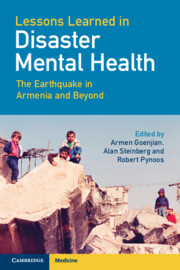Book contents
- Lessons Learned in Disaster Mental Health: The Earthquake in Armenia and Beyond
- Frontispiece
- Lessons Learned in Disaster Mental Health: The Earthquake in Armenia and Beyond
- Copyright page
- Contents
- Dedication
- Preface
- Contributors
- Chapter 1 The 1988 Spitak Earthquake in Armenia and the Implementation of the Psychiatric Outreach Program
- Chapter 2 Diaspora Therapists Working in the Earthquake Zone
- Chapter 3 Treatment Outcome among Early Adolescents Two Decades Post-Earthquake
- Chapter 4 Course and Predictors of PTSD and Depression among Not Treated Children and Adolescents over Two Decades
- Chapter 5 Conscience, Moral Injury, and Psychopathology
- Chapter 6 Natural Disasters and Relocation
- Chapter 7 Long-Term Course of PTSD and Depression Among Adults, Mediating and Moderating Factors in Recovery, and Current Trends for Treatment
- Chapter 8 How the Spitak Earthquake Contributed to our Understanding of the Genetics of PTSD and Associated Disorders
- Chapter 9 Epidemiology of Disasters and the Spitak Earthquake
- Chapter 10 Traumatic Stress Conceptual Framework
- Chapter 11 Memoirs of the Spitak Earthquake
- Chapter 12 Lessons Learned from the Spitak Earthquake and Other Catastrophic Disasters
- Index
- Plate Section (PDF Only)
- References
Chapter 8 - How the Spitak Earthquake Contributed to our Understanding of the Genetics of PTSD and Associated Disorders
Published online by Cambridge University Press: 20 May 2022
- Lessons Learned in Disaster Mental Health: The Earthquake in Armenia and Beyond
- Frontispiece
- Lessons Learned in Disaster Mental Health: The Earthquake in Armenia and Beyond
- Copyright page
- Contents
- Dedication
- Preface
- Contributors
- Chapter 1 The 1988 Spitak Earthquake in Armenia and the Implementation of the Psychiatric Outreach Program
- Chapter 2 Diaspora Therapists Working in the Earthquake Zone
- Chapter 3 Treatment Outcome among Early Adolescents Two Decades Post-Earthquake
- Chapter 4 Course and Predictors of PTSD and Depression among Not Treated Children and Adolescents over Two Decades
- Chapter 5 Conscience, Moral Injury, and Psychopathology
- Chapter 6 Natural Disasters and Relocation
- Chapter 7 Long-Term Course of PTSD and Depression Among Adults, Mediating and Moderating Factors in Recovery, and Current Trends for Treatment
- Chapter 8 How the Spitak Earthquake Contributed to our Understanding of the Genetics of PTSD and Associated Disorders
- Chapter 9 Epidemiology of Disasters and the Spitak Earthquake
- Chapter 10 Traumatic Stress Conceptual Framework
- Chapter 11 Memoirs of the Spitak Earthquake
- Chapter 12 Lessons Learned from the Spitak Earthquake and Other Catastrophic Disasters
- Index
- Plate Section (PDF Only)
- References
Summary
The Spitak earthquake offered a unique opportunity to conduct family studies of the genetics of post-traumatic stress disorder (PTSD) and related conditions, including depression and anxiety. The multigenerational families that participated in the Spitak Earthquake Genetic Study (SEGS) were recruited from the devastated city of Gumri. The participants (3 to 5 generations) were exposed to horrific earthquake-related traumatic experiences contemporaneously. After adjusting for sex, age, and multiple environmental risk factors, the heritability of vulnerability of PTSD (42%) was significant. Additionally, vulnerabilities for depression and anxiety were also significantly heritable. These three phenotypes were genetically correlated, indicating pleiotropy, i.e., they shared genes. Using complex co-variate analyses, we found an association of specific serotonergic genes (THP2 and THP1) and a dopaminergic gene (COMT) with PTSD and a serotonergic gene (5HTTLRP) with depression. These findings suggest that carriers of variants of these genes are at risk for PTSD and depression, respectively. Whole genome sequencing found another interesting gene, OR4C3, among those with PTSD. The gene codes for an olfactory receptor that shares a domain structure with many neurotransmitters. The chapter also discusses recent advances and challenges in genetic research.
- Type
- Chapter
- Information
- Lessons Learned in Disaster Mental HealthThe Earthquake in Armenia and Beyond, pp. 137 - 151Publisher: Cambridge University PressPrint publication year: 2022

